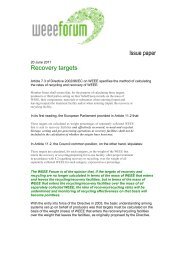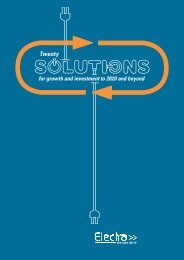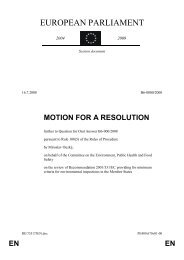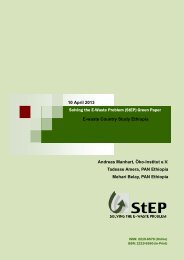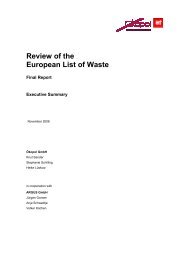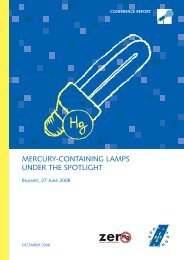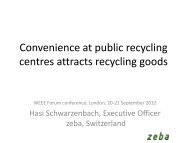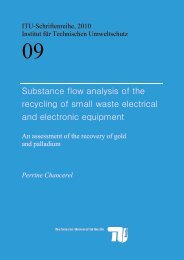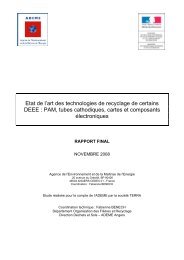by SENS and SWICO - Ecotic
by SENS and SWICO - Ecotic
by SENS and SWICO - Ecotic
Create successful ePaper yourself
Turn your PDF publications into a flip-book with our unique Google optimized e-Paper software.
PCB’s in Small Capacitors from Waste Electrical <strong>and</strong> Electronic Equipments1 Initial Situation <strong>and</strong> Target1.1 Capacitors <strong>and</strong> EnvironmentSmall capacitors are passive electrical building elements<strong>and</strong> found in many electrotechnical devices. Inelectrical <strong>and</strong> electronic equipments, they serve as energy<strong>and</strong> charge-coupled memory, frequency dependingresistances, converters or sensors. A capacitor consistsof two electro-conducting surfaces, mostly at small intervals,i.e. the electrodes. Between them, there is alwaysan area with isolating properties, the dielectric,which may be solid or liquid. The case of one of theelectrodes formed <strong>by</strong> a conducting liquid refers to anelectrolyte capacitor. The dielectric is found in the aluminiumoxide (Al 2O 3) or tantalum oxide (Ta 2O 5) of theelectrolyte capacitor, generated as a chemical reactionbetween electrodes <strong>and</strong> electrolytes. Most current designsare winding capacitors (i.e. paper sheet, syntheticsheet, metal paper systems), mass capacitors (i.e. ceramic<strong>and</strong> electrolyte capacitors) <strong>and</strong> layer capacitors(Hentschel 2000).Due to the electrical insulating property, diffi cult infl ammability,chemical <strong>and</strong> thermal stability of polychlorinatedbiphenyls (PCB’s), these chemical chlorine compoundswere often used as dielectrics in paper capacitors.As a consequence of their hazardous impacts onhuman health (BAG 2006) <strong>and</strong> their extraordinary stability,the production <strong>and</strong> application of PCB’s in Switzerl<strong>and</strong>was generally prohibited in 1986. On an internationallevel, the production <strong>and</strong> application of PCB’s wasbanned, fi rst in open systems in 1978 <strong>and</strong> then broadlyprohibited in 1986 (UNEP 1999). Various non-conductiveoils, mainly without halogens, were used as substitutesfor PCB’s. But as these substitutes must also havea certain thermal <strong>and</strong> electrical stability, the environmentalhazard cannot be excluded. In Al capacitors,organic carbonic acids – heavily toxic <strong>and</strong> corrosive(Baumann 2005) – are frequently used as electrolytes.These electro-conductive matters are often mixed withadditives <strong>and</strong> solvents.1.2 Legal Provisions <strong>and</strong> System RegulationsIn 2006, 121 t small capacitors from 96’400 t electrical<strong>and</strong> electronic waste equipments were removed <strong>and</strong>disposed of separately in Switzerl<strong>and</strong> (<strong>SENS</strong>-<strong>SWICO</strong>2007) . The Swiss legal provisions differentiate on principlebetween the disposal routes for PCB-containing<strong>and</strong> PCB-free capacitors. According to the Swiss Ordinanceon the Return, Acceptance <strong>and</strong> Disposal of Electrical<strong>and</strong> Electronic Equipments (VREG), Art. 6 Abs. 1lit. a (VREG 1998), “especially contaminated componentssuch as PCB-containing capacitors must be disposedof separately”. The guidance on the VREG (BU-WAL 2000) stipulates high-temperature incineration forPCB-containing capacitors.Specifi c requirements for the disposal of PCB-free capacitorsare not defi ned in the Swiss legislation, unlesstheir classifi cation as “heavily contaminated components”can be justifi ed. According to the VeVA Waste Catalogue(Ordinance on the H<strong>and</strong>ling of Waste), PCB-freecapacitors are assigned to the other wastes which aresubject to control (Waste Code: 16 02 16 [ak]).In Annex 2 (EU 2002) of the European WEEE Directive,the removal from equipments <strong>and</strong> a separate disposalof PCB-containing capacitors <strong>and</strong> electrolyte capacitorswith environmentally relevant matters (height> 25 mm; diameter > 25 mm or proportionally similarvolumes) are stipulated. Following the European WasteCatalogue, these capacitors are also ranked as hazardouswaste.The Treatment Requirements of the Swiss system operators<strong>SENS</strong> <strong>and</strong> <strong>SWICO</strong> on the disposal of electrical <strong>and</strong>electronic equipments are ruling the h<strong>and</strong>ling of smallcapacitors in accordance with Swiss <strong>and</strong> Europeanst<strong>and</strong>ards. Basing on the defi nition in Annex 2 of theWEEE Directive, all the PCB-containing <strong>and</strong> electrolytecapacitors shall be removed from the equipments <strong>and</strong>disposed of separately.In practice, a differentiation between PCB-containing<strong>and</strong> PCB-free capacitors is diffi c ult – also for qualifi edpersonnel – cost <strong>and</strong> time intensive, <strong>and</strong> therefore rarelydone. Available auxiliary documents for identifying6



